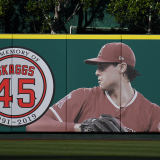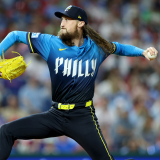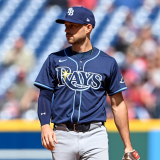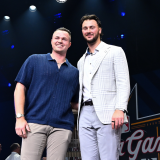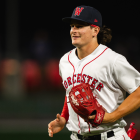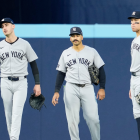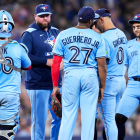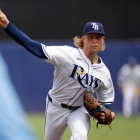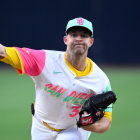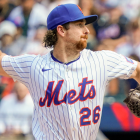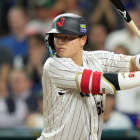MLB prospect rankings: Top 25 players entering 2025 with Roman Anthony at No. 1, plus likely debut timelines
See where Dylan Crews, Andrew Painter, Jasson Domínguez and more top prospects landed on CBS Sports' list

The offseason can mean only one thing: it's time to rank some prospects.
As is tradition here at CBS Sports, we roll out our minor-league prospect coverage in stages. Below, you'll find our initial top-25 prospects list. We then publish our top prospect lists for all 30 individual teams. Before the start of spring training, we'll run our full top 50.
All of our lists are shaped by a variety of inputs. Those include conversations with scouts, analysts, and other front-office types; statistical and observational analysis; and so on. We must emphasize that we don't care if our lists look different than other publications -- variety is the spice of baseball analysis, and everyone has their own methods and predilections.
Now, let's get to the reason you clicked.
1. Roman Anthony, OF, Red Sox
The short hook: Accomplished young outfielder with room to grow
Anthony has a lot working in his favor. He won't celebrate his 21st birthday until the summer, yet he's already authored an impressive 35-game stretch in Triple-A, during which he recorded a .983 OPS and a walk for every strikeout. His advanced metrics, including his 90th percentile exit velocity and his in-zone contact percentage, line up with those posted by James Wood and Junior Caminero; his chase rate, meanwhile, was superior to both. (Wood and Caminero subsequently hit well in the majors.) If there's an area where Anthony could obviously stand to improve, it has to be with respect to pulling the ball in the air. He has immense raw strength, the kind that could eventually result in 30-plus homers annually; it's eyebrow-raising, then, that he pulled just 4% of his Triple-A fly balls (the MLB average last season was over 9%). This ranking is a bet on Anthony's youth and talent allowing him to figure out that component over the coming years. Even without it, he's a high-quality prospect nearing arrival. MLB ETA: Spring 2025
Red Sox #2 prospect Roman Anthony clubs his team-leading 14th home run of the season. pic.twitter.com/pnQflU20gn
— Portland Sea Dogs (@PortlandSeaDogs) August 9, 2024
2. Dylan Crews, OF, Nationals
The short hook: Capable center fielder with above-average offensive potential
When it comes to prospects, familiarity can beget fatigue as efficiently as it can breed contempt. Crews, nearing his fifth consecutive year on the national radar, remains a quality prospect (several sources argued for him in the top spot) despite having not achieved instant stardom like his collegiate teammate Paul Skenes. He combines center-field athleticism with above-average offensive traits; even during his month-long cameo in the majors, he showed an aptitude for making sound contact and minding the strike zone. Crews' swing isn't conducive to maximizing his home-run count, but in the near term his output at the plate could resemble something along the lines of Randy Arozarena (who, over the last four seasons, has averaged 21 home runs and 24 stolen bases to go with a 120 OPS+). MLB ETA: Already debuted
3. Kristian Campbell, SS/2B/CF, Red Sox
The short hook: The breakout prospect of the year
Campbell has greatly boosted his stock since being drafted in the fourth round during summer 2023. He trained his bat speed over the winter, empowering him to launch 20 home runs last year after smoking only four during his single season at Georgia Tech. Campbell's added muscle gives him a well-rounded game: he has a good feel for contact and the zone alike; he's an above-average runner; and the Red Sox continue to play him at shortstop, albeit while giving him looks elsewhere on the diamond, too. Campbell already has the appearance of being a draft-day steal. Expect him to continue to enhance that perception in 2025, likely while spending a lot of time in the majors. MLB ETA: Spring 2025
4. Walker Jenkins, OF, Twins
The short hook: Polished hitter beyond his years
Jenkins injured himself in the first game of the regular season, causing him to miss more than a month of action. Said absence didn't prevent him from progressing all the way to Double-A in what served as his age-19 and first full professional season. Jenkins can really hit, as demonstrated by the fact he batted .282/.394/.439 with more walks than strikeouts in 82 games spread across four levels. Provided Jenkins can tap more into his plus strength heading forward -- and there's no apparent reason that he shouldn't -- he should develop into a middle-of-the-order fixture for the Twins. MLB ETA: Summer 2026
5. Carson Williams, SS, Rays
The short hook: All-Star upside, but with some risk
Williams is a good defensive shortstop with at least 20-20 offensive potential thanks to his above-average (or better) power and speed combination. Those traits give him a high ceiling, but his ability to reach his absolute peak will be tested by a substandard hit tool. Williams has consistently struck out 28% or more of the time throughout his minor-league career, a frequency matched by only a few big-league shortstops. He has enough going for him to think he'll be able to withstand that blemish; at the same time, he could develop into an MVP candidate if he can make more consistent contact. MLB ETA: Summer 2025
6. Jackson Jobe, RHP, Tigers
The short hook: One of the game's better pitching prospects has to stay on the mound
Jobe made his first handful of big-league appearances late in the year, including pitching twice during the postseason. Next on the to-do list? Make his first MLB start. That ought to come sometime in 2025 thanks to a four-pitch arsenal that includes a rising mid-90s fastball, a cutter and a sweeper, and a changeup. Jobe battled his command throughout the season, but the bigger question mark here is his durability. He threw a career-high 95 innings in 2024, suggesting that he'll need his workload managed to avoid being shut down before the regular season concludes. MLB ETA: Already debuted
Jackson Jobe's first Major League game and he closes the door on another @Tigers win 🤩 pic.twitter.com/BjZjkbj29K
— MLB (@MLB) September 26, 2024
7. Colt Emerson, SS, Mariners
The short hook: Polished lefty-hitting shortstop
Emerson had scouts swooning in the spring. He made good on that preseason hype during the year, impressing in both the California and Arizona Fall Leagues while scuffling in the Northwest League to round out his regular season. It's hard to get too worked up about the latter experience; he was nearing the end of his first full year as a professional (a season that contained multiple trips to the injured list, mind you), and he was playing in leagues as a teenager that featured pitchers several years older. What's important here is that Emerson projects as an above-average lefty-hitting shortstop who just needs to tap into his raw power during games. If he can do that, he'll become a foundational piece of the Mariners' long-term plans. MLB ETA: Summer 2026
8. Samuel Basallo, C/1B, Orioles
The short hook: Powerful lefty bat with positional questions
Basallo is a potential middle-of-the-order fixture, an imposing figure with the strength to match. That size, plus his spotty receiving and Adley Rutschman's continued presence on the Orioles roster, has long swayed evaluators to discount his chances of remaining behind the plate. Sure enough, Basallo made more combined starts at first base and DH in 2024 than he did at catcher. It's hard to know how much of that had to do with injuries he suffered (including a stress fracture in his throwing elbow) and how much of that had to do with the Orioles accepting his eventual relocation down the defensive spectrum as a fait accompli. Basallo's bat is the drawing point regardless, and the reason he ranks so highly despite the uncertainty. MLB ETA: Late summer 2025
9. Jordan Lawlar, SS, Diamondbacks
The short hook: Dynamic shortstop just needs better health
Lawlar was limited to just 23 regular-season games, all on the minor-league side, by a combination of hamstring and thumb injuries. He'll now enter his fourth full professional season having yet to appear in more than 119 games in a single year. Lawlar nonetheless remains a compelling prospect. He offers plus defense at the six as well as above-average power and speed tools that should more than offset his swing-and-miss tendencies. If Lawlar's body allows, he should spend most of the upcoming season serving as Arizona's everyday shortstop. MLB ETA: Already debuted
10. Marcelo Mayer, SS, Red Sox
The short hook: Talented shortstop with durability concerns
Unavailability has become the theme of Mayer's professional career. He's still yet to play in 100 games in a season, having missed most of the second half of 2024 on account of a lumbar strain that prevented him from making his Triple-A debut. Mayer had a good year when he was hearty and hale, nearly matching Roman Anthony's OPS at Double-A. He's added strength (and swing and miss) since draft night, and he continues to be an effective shortstop with more quickness than straight-line speed. That makes for a good prospect, albeit one with a spotty health track record. MLB ETA: Summer 2025
11. Max Clark, OF, Tigers
The short hook: Well-rounded center fielder
Clark has elicited comparisons to Cubs outfielder Pete Crow-Armstrong since his amateur days. We must admit that, while we dislike comps in general, there's something to this one. Clark, like Crow-Armstrong, is a strong defender who can offer ample value on the basepaths, though neither offers a ton of in-game power at this point in their careers (Clark's 107 mph maximum exit velocity would've ranked right alongside Crow-Armstrong near the bottom of the majors). The biggest difference, besides them being their own carbon-based organisms, is that Crow-Armstrong is already established on the Cubs roster and Clark is likely to start 2025 in High- or Double-A. Give it another year and some change and they'll share something else: the majors. MLB ETA: Late summer 2026
12. Travis Bazzana, 2B, Guardians
The short hook: Last summer's No. 1 pick can really hit
The Guardians' love for Bazzana was a poorly kept secret within the industry, with several talent evaluators identifying him to CBS Sports as the likely No. 1 pick before the college season even got underway. Whether or not the Guardians ever wavered on their selection is for them to know, but Bazzana did his part to keep them engaged. He again showed off a well-rounded offensive game that includes excellent swing decisions and both above-average strength (despite a smaller frame) and speed. A substandard arm will limit him to second base, and it's fair to write that he's maxed out physically -- something that divides scouts when it comes to draft prospects. Evaluators have long raved about Bazzana's work ethic, however, suggesting he'll be able to make any additional gains that are available to him, be they physical or otherwise. MLB ETA: Spring 2026
TRAVIS BAZZANA PLAYOFF HOMERS HAVE ENTERED THE CHAT ‼️
— Minor League Baseball (@MiLB) September 13, 2024
Watch the rest of the @DragonsBaseball vs. @LCCaptains Midwest League semis clash FREE: https://t.co/DUjagi3wZL@CleGuardians | @GuardsInsider | @BeaverBaseball pic.twitter.com/1vBAXecuK3
13. JJ Wetherholt, 2B/SS, Cardinals
The short hook: Potential draft-night steal has a well-rounded game
Wetherholt slipped to the seventh pick last summer after missing half of the collegiate season because of a hamstring injury. In due time, he might reveal himself to be the best player in the class. Wetherholt has plenty working in his favor, beginning with appreciable feels for the barrel and the zone that have scouts throwing double-plus projections on his hit tool. He's not likely to be a huge power threat, and he's almost certain to move across the bag to second base before he reaches the majors. (Masyn Winn exists, after all.) Even so, Wetherholt has the makings of a quick-moving regular who inspires regret in at least a few of the teams that passed on him. MLB ETA: Spring 2026
14. Andrew Painter, RHP, Phillies
The short hook: Prolonged absence hasn't diminished upside
Painter returned to the mound during the Arizona Fall League after being sidelined for the past two seasons by Tommy John surgery. He demonstrated his health, touching 99 mph while generating plenty of swinging strikes with both his curveball and slider. Painter seemed certain to make his debut in 2023. Now, the Phillies may choose to take things a little slower with him on account of his presumed workload limitations. Either way, a healthy Painter continues to profile as a top prospect. MLB ETA: Summer 2025
15. Chase Burns, RHP, Reds
The short hook: The first pitcher drafted last summer is electric
Burns didn't pitch after being selected with the No. 2 pick in last summer's draft. He'd already thrown 100 innings on the year, or 20 more innings than his previous high. Once he does take a professional mound for the first time, he should find himself on the inside track to the majors. Burns has a well-rounded arsenal, including an explosive upper-90s fastball and two high-quality breaking balls. He has good control, having walked fewer than three batters per nine innings in college, though he could stand to improve his command. Any gains on that front ought to give him No. 2 starter upside. MLB ETA: Spring 2026
16. Chase Dollander, RHP, Rockies
The short hook: Fastball-slider pairing should enable 2025 debut
Dollander entered the 2023 draft cycle viewed as the best pitcher in the class thanks to an arsenal led by a stellar fastball-slider combination. He was eventually surpassed (and then some) by Paul Skenes while he battled consistency woes. Since turning pro, however, he's done well to remind folks why he was highly touted in the first place. Dollander split last season between High- and Double-A, striking out more than a third of the batters he faced (albeit with an inflated walk rate) and positioning himself to make his big-league debut sometime in 2025. It's never easy pitching home games at Coors Field, but Dollander has at least mid-rotation upside if he can stay on track. MLB ETA: Spring 2026
17. Emmanuel Rodriguez, OF, Twins
The short hook: Extreme offensive game, extreme injury history
Rodriguez is a rara avis among high-quality offensive prospects. He's so picky at the plate that he makes Juan Soto seem overeager. Such discernment has resulted in more than half of his career plate appearances ending in a walk (21.9%) or a strikeout (29.9%). When Rodriguez does put the ball in play, he displays above-average thump. He's also a good defender. The most worrisome aspect here is how sparse he's been in four professional seasons: just once has he played in more than 50 games, and he's yet to clear the 100-game threshold (though he finished 2023 with 99 appearances). The error bars are so wide here, on account of Rodriguez's odd skill set and unreliably availability, that this could end up looking like a brutal misrank in either direction. MLB ETA: Late summer 2025
18. Ethan Salas, C, Padres
The short hook: Patience is a virtue
Your mileage may vary on Salas. The twain seldom meets when it comes to extreme youth and upper-level minor-league baseball. Yet Salas, who won't celebrate his 19th birthday until June, has already recorded 120 games at the High-A level. That combination makes it tough to hold his poor offensive results against him; after all, he was more than four years the junior of his average opponent. Behind the plate, Salas is unthinkably polished. At the plate? Well, George Harrison sang it best: "It's gonna take time, whole lotta precious time." We'll give him another year, at least, before we start seriously considering moving him down lists. MLB ETA: Spring 2026
ETHAN SALAS GO-AHEAD ROUNDTRIPPER 🍎@TinCaps | @Padres pic.twitter.com/6f1AVvMS5P
— Minor League Baseball (@MiLB) August 7, 2024
19. Leodalis De Vries, SS, Padres
The short hook: Teenage switch-hitting shortstop with big upside
The Padres, always game to challenge their best young prospects with an aggressive assignment, tasked 17-year-old De Vries with a full season in the California League just months after signing him for more than $4 million. Although he would've been young for the draft, and although he was facing competition that was on average four years his senior, he produced at a level 16% above the league-average mark. (Later, in the Fall League, he hit a ball with a 110 mph exit velocity that would've qualified as the fastest of the season save for the likes of J.T. Realmuto, Rhys Hoskins, and Mookie Betts.) That kind of age-relative performance bodes extremely well for De Vries' long-term outlook, and makes it easy to justify giving him a bullish ranking despite his youth. MLB ETA: Spring 2027
20. Sebastian Walcott, SS, Rangers
The short hook: Immense risk, immense reward
One of the most encouraging things a hitting prospect can do is perform well when they're significantly younger than their competition. Walcott did just that, more than holding his own as an 18-year-old in High-A, where he routinely faced pitchers who were four years his senior. Walcott has the size and innate explosive attributes necessary to develop into a middle-of-the-order force. Given the circumstances, consider it reassuring that he struck out just 25.5% of the time -- particularly since hit tool concerns were one of the biggest question marks facing his game. Another? Whether or not he'll outgrow the shortstop position, necessitating a move to third base. For now, Walcott's bat seems promising enough to render the matter moot. MLB ETA: Spring 2027
21. Jasson Domínguez, OF, Yankees
The short hook: The Martian is ready to make contact
Domínguez is, without rival, the most famous person on this list. He's been nationally relevant since first signing with the Yankees as a 16-year-old and, as a reward, receiving the burden of unreasonable comparisons. The ensuing years have lowered the volume on the hype machine, but that doesn't mean he's a bust. Rather, Domínguez projects as a starting-caliber outfielder who can provide power and speed -- particularly when there's a right-handed pitcher on the bump. Though he switch-hits, he's always performed better from the left side; it's where he has a finer command of the strike zone and the barrel alike. Domínguez's plate discipline and explosiveness should enable him to record his first full big-league season in 2025. MLB ETA: Already debuted
22. Dalton Rushing, C/OF, Dodgers
The short hook: Will hit wherever he plays
Rushing has primarily served as a backstop during his professional career, making it notable that the Dodgers shifted him to left field on a nearly exclusive basis after promoting him to Triple-A. (Los Angeles, you may have heard, has a good catcher in place for the next nine years.) Rushing is the rare catching prospect with the bat to play far down the defensive spectrum. He's an on-base machine who seldom expands his strike zone to chase bad pitches. He has more than enough juice to keep pitchers honest, too, having averaged a 90 mph exit velocity during his time in Triple-A. Rushing even had a minimal platoon split, posting an almost identical OPS against lefties and righties alike. He's all but certain to play a role in the majors in 2025. Stay tuned to find out with which team and at what position. MLB ETA: Spring 2025
23. Bubba Chandler, RHP, Pirates
The short hook: Athletic right-hander with promising arsenal
Just what the Pirates need: another talented young right-handed pitcher. Chandler was one of the overslot picks the Pirates splurged on in 2021, after they took Henry Davis at No. 1 and embraced the portfolio approach. He's an excellent athlete who has continued to improve his control as a professional. Chandler's arsenal includes a rising fastball that can touch 99 mph and two promising secondaries, in his changeup and slider. He closed out the season in Triple-A and seems certain to debut in 2025. MLB ETA: Spring 2025
24. Coby Mayo, 1B/3B, Orioles
The short hook: Corner infielder with power, patience
As sure as night gives in to day, the Orioles' best young hitters struggle during their first big-league foray. Mayo was no exception, punching out 22 times in 46 trips to the plate. Rest assured, he'll get ample opportunity to turn his ship around. Mayo has both great strength (he recorded a 114.9 mph batted ball in Triple-A) and a healthy commitment to taking free passes. He does swing and miss a fair amount, but more often than not he's kept his strikeout rate in check. Mayo's defensive home has been a long-term question mark; in part because of his own athletic limitations, and in part because the Orioles have a seemingly endless supply of budding infielders. Provided his bat ports in whole, it won't really matter what positions he ends up staffing. MLB ETA: Already debuted
25. Josue De Paula, OF, Dodgers
The short hook: Teenage outfielder with room to grow
De Paula, one of our breakout picks last spring, validated the selection by hitting around 30% better than the league-average mark and walking nearly as often as he struck out across two levels of play. Not bad for someone who won't celebrate his 20th birthday until late next May. De Paula still needs to tap into his above-average strength on a more reliable basis; he homered only 10 times total last season and he hit nearly 50% ground balls during his 52-game stint in High-A. He's shown enough promise overall to merit a high ranking with the potential to make a big leap in 2025. MLB ETA: Late summer 2026


